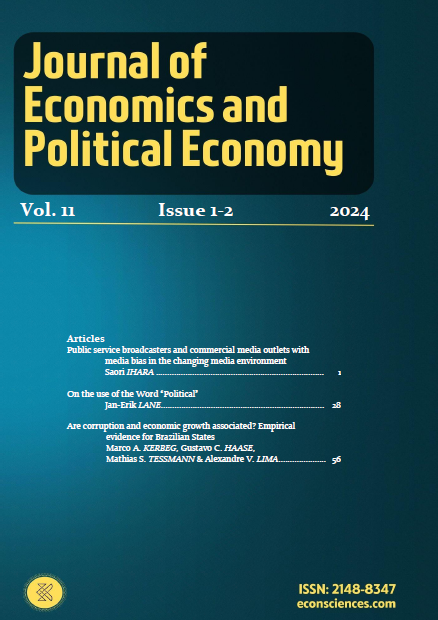Abstract
This paper seeks to investigate whether corruption influences and may be associated with per capita economic growth in Brazilian states. For this, information about per capita economic growth and an indicator of corruption for each Brazilian state are considered, in addition to control variables that aim to isolate the influence of corruption, such as the illiteracy rate of young people over 15 years old, population, GDP real, real GDP per capita, openness, total public expenditure, total public expenditure weighted by real GDP, total credit weighted real GDP and value-added of agriculture weighted by real GDP. The effects of these variables on per capita income are not linear and that is why the generalized method of moments (GMM) in 1st difference is used. The results indicate that corruption and economic growth are associated, and the three estimated models present the variables referring to the corruption indicator as statistically significant. These findings are useful for the scientific literature that investigates the influence of corruption on economic growth by bringing empirical evidence to Brazil and for more efficient decision-making by political decision-makers in combating corruption and the use of public resources.
Keywords. Economic growth; Corruption; Population; Real GDP per capita; GMM.
JEL. E02, E23, O11, O47.
References
Ades, A., & Tella, R.D. (1999). Rents competition and corruption. American Economic Review, 89(1), 982–993. doi. 10.1257/aer.89.4.982
Ahmad, N. (2008). Corrupt clubs and the convergence hypothesis. The Pakistan Development Review, 45, 1001–1009.
Aidt, T., Dutta, J., & Sena, V. (2008). Governance regimes, corruption and growth: Theory and evidence. Journal of Comparative Economics, 36, 195–220. doi. 10.1016/j.jce.2007.11.004
Aliyu, S.U.R., & Elijah, A.O. (2008). Corruption and economic growth in Nigeria: 1986–2007. MPRA Paper, No. 12504. [Retrieved from].
Alexeev, M., & Song, Y. (2013). Corruption and product market competition: An empirical investigation. Journal of Development Economics, 103, 154–166. doi. 10.1016/j.jdeveco.2013.02.010
Al-Marhubi, F.A. (2000). Corruption and Inflation. Economics Letters, 66(2), 199-202. doi. 10.1016/S0165-1765(99)00230-X
Bertussi, G.L. (2010). Gastos públicos com infra-estrutura de transporte e crescimento econômico: Uma análise para os estados Brasileiros. Tese (Doutorado em Economia) - UnB. [Retrieved from].
Boll, J.L.S. (2010). A corrupção governamental no brasil: construção de indicadores e análise da sua incidência relativa nos estados brasileiros. Dissertação (Mestrado em Economia do Desenvolvimento) – PUCRS. [Retrieved from].
Bliss, C., & Tella, R.D. (1997). Does Competition Kill Corruption? Journal of Political Economy, 105(5), 1001–1023. doi. 10.1086/262102
Brei, M., Ferri, G., & Gambacorta, L. (2018). Financial structure and income inequality. BIS Working Papers, Monetary and Economic Department, No.756. [Retrieved from].
Caldeira, D.R. (2016). Corruption in Brazil and its Effects on Economic Growth. Tallinn University of Technology, School of Economics and Business Administration. Department of Finance and Economics. Chair of Theoretical Economics. [Retrieved from].
Carraro, A., Fochezatto, A., & Hillbrecht, R.O. (2006). O impacto da corrupção sobre o crescimento econômico do brasil: aplicação de um modelo de equilíbrio geral para o período 1994-1998. ANPEC: Área 5 - Crescimento, Desenvolvimento Econômico e Instituições. [Retrieved from].
Choi, J.P., & Thum, M. (1999). The economics of repeated extortion. The Rand Journal of Economics, 35(2), 203–223. doi. 10.2307/1593688
Hall, A.R. (2011). Generalized Method of Moments. University of Manchester. [Retrieved from].
Ho, Y.H., & Huang, C.J. (2011). The corruption-economic growth nexus: Evidence from four BRIC countries based on the panel data approach. Journal of Global Business & Technology, 7(2), 44-53.
Huang, C.J. (2016). Is corruption bad for economic growth? Evidence from Asia-Pacific countries. The North American Journal of Economics and Finance, 35, 247-256. doi. 10.1016/j.najef.2015.10.013
Jiang, T., & Nie, H. (2014). The stained China miracle: Corruption, regulation, and firm performance. Economics Letters, 123, 366–369. doi. 10.1016/j.econlet.2014.03.026
Knack, S., & Keefer, P. (1995). Institutions and economic performance: Cross-country tests using alternative institutional measures. Economics and Politics, 7(3), 207–227. doi. 10.1111/j.1468-0343.1995.tb00111.x
Leite, C., & Weidmann, J. (2002). Does mother nature corrupt? Natural resources, corruption, and economic growth. In G.T. Abed & S. Gupta (Eds.), Governance, Corruption, & Economic Performance. Washington: International Monetary Fund, Publication Services.
Mauro, P. (1995). Corruption and crowth. The Quartely Journal of Economics, 110(3), 681-712. doi. 10.2307/2946696
Mauro, P. (2017). Why worry about corruption? FMI, Economic Issues, No.6. [Retrieved from].
Mauro, P. (1998). Corruption and the composition of government expenditure. Journal of Public Economics, 69(2), 263-279. doi. 10.1016/S0047-2727(98)00025-5
Méon, P.G., & Sekkat, K. (2005). Does corruption grease or sand the wheels of growth? Public Choice, 122, 69-97. doi. 10.1007/s11127-005-3988-0
Neeman, Z., Paserman, D., & Simhon. A. (2004). Corruption and openness. Department of Economics. Hebrew University Working Paper, No.353. [Retrieved from].
Özsahin, S., & Üçler, G. (2017). The consequences of corruption on inflation in developing countries: Evidence from panel cointegration and causality tests. Economies, 5(4), 49. doi. 10.3390/economies5040049
Pellegrini, L., & Gerlagh, R. (2008). Causes of corruption: A survey of cross country analyses and extended results. Economics of Governance, 9, 245–263. doi. 10.1007/s10101-007-0033-4
Svensson, J. (2005). Eight questions about corruption. Journal of Economic Perspectives, 19(3), 19–42. doi. 10.1257/089533005774357860
Tanzi, V., & Davoodi, H. (1998). Corruption, public investment, and growth. In The welfare state, public investment, and growth. [S.l.]: Springer, p. 41–60. [Retrieved from].

This work is licensed under a Creative Commons Attribution-NonCommercial 4.0 International License.
